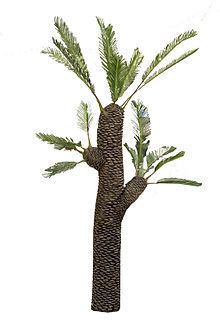Scientific name Williamsonia Rank Genus | Division Cycadeoidophyta Higher classification Williamsoniaceae | |
 | ||
Similar Bennettitales, Cycadeoidea, Williamsoniaceae, Cycad, Zamites | ||
Williamsonia is an extinct genus of plant belonging to Bennettitales, an order of seed plants which bore a resemblance to cycads. Fossilized specimens of Williamsonia have been discovered worldwide.
Contents
Taxonomy
Williamsonia was originally described as Zamia gigas by William Crawford Williamson. William Carruthers proposed the name Williamsonia in an 1870 paper of his, with the type species being W. gigas.
Biology
Williamsonia possessed a sturdy stem and had multiple fern-like leaves. The plant did not live in groups. The stamens of Williamsonia curved inward and upward.
Williamsonia produced flowers up to 4 inches (10 cm) in length. Its stalked seeds would have grown from a central receptacle, and the entire flower of Williamsonia would have been surrounded by protective bracts (which are often the only part of the plant to undergo fossilization). The cones of Williamsonia were monosporangiate. They were "cup shaped" and could be up to 15 centimetres (5.9 in) in diameter. As many as 25-50 ovules could be present in each cone. The development of the ovules appears to be similar to that of Cycadeoidea.
Fossil sites
An anatomically preserved cone of Williamsonia has been discovered in Campanian rocks of Vancouver Island. This was the first reproductive structure of Williamsoniaceae to be recovered from western North America. Bennettitalean cones (8 centimetres (3.1 in) in length and 6 centimetres (2.4 in) in diameter) from the Crato Formation of Brazil may belong to Williamsonia, as well as finds from the Gristhorpe Beds of Cayton, England (in this case the specific species W. leckenbyi). In addition, W. harrisiana has been described from the Rajmahal Hills of India, as well as W. nizhoniamcdouldsd from the Chinle Formation of New Mexico.
In Brazil, it was found Williamsonia in Paleorrota geopark that were in the Santa Maria Formation, dating from Carnian, Upper Triassic.
